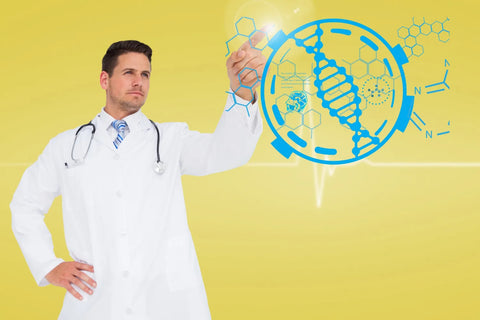Nicotinamide mononucleotide (NMN) and nicotinamide riboside (NR) serve as precursors to nicotinamide adenine dinucleotide (NAD+), a crucial molecule for metabolism. Studies suggest that NAD+ levels decline with agen vs nr, but replenishing them may extend lifespan and improve health. Research indicates that both NMN and NR supplements can boost NAD+ levels in aging individuals. What sets these NAD+ precursors apart? Let's explore their differences

Differences between NMN and NR
Nicotinamide mononucleotide (NMN) and nicotinamide riboside (NR) are both compounds that serve as precursors to nicotinamide adenine dinucleotide (NAD+), a crucial coenzyme involved in various metabolic processes. While they share the common goal of replenishing NAD+ levels, there are notable differences between NMN and NR that affect their roles and efficacy.
Molecular Structure
NMN: NMN consists of a nicotinamide base attached to a ribose molecule, with an additional phosphate group. This structure makes NMN larger and more complex.
NR: In contrast, NR features a similar structure to NMN but lacks the phosphate group, resulting in a smaller molecular size.
Cellular Uptake
NMN: Research suggests that NMN may require specific transporters, such as Slc12a8, to facilitate its entry into cells. Alternatively, NMN may need to convert to NR before cellular uptake.
NR: NR can be efficiently transported into cells without the need for conversion, making it a more direct precursor to NAD+ synthesis.
Metabolic Conversion
NMN: Once inside cells, NMN undergoes enzymatic conversion into NR by nucleotidases before contributing to NAD+ synthesis pathways.
NR: NR can be directly utilized by cells as a substrate for NAD+ synthesis, bypassing the need for additional enzymatic conversion steps.
Research and Applications
NMN: NMN has gained attention in aging research and potential therapeutic interventions aimed at restoring NAD+ levels and addressing age-related decline.
NR: Similarly, NR supplements have shown promise in boosting NAD+ levels and addressing metabolic imbalances associated with aging.
Exploring the Safety of NMN and NR Supplement
As interest in NMN and NR supplements rises, it's important to understand their safety. Let's look into how safe these supplements are.

Clinical Studies:
Researchers have studied NMN and NR in trials. These studies show that people generally tolerate them well, with few side effects.
Short-Term Safety:
In short-term studies, most people don't have serious side effects from NMN and NR. Some may experience mild stomach problems like nausea or diarrhea, but these usually go away quickly.
Long-Term Safety:
We don't have much data on long-term use yet. But from what we know, using NMN and NR for a long time doesn't seem to cause major problems in healthy people.
Potential Risks and Considerations:
If you have health issues or take medications, talk to your doctor before trying NMN or NR. They can help you understand if these supplements are safe for you.
Regulatory Oversight:
NMN and NR are sold as dietary supplements, so they aren't regulated as strictly as medicines. This means quality and safety can vary between brands.
Future Research Directions:
More studies are needed to fully understand the safety of NMN and NR, especially in the long term and for certain groups of people. We also need better quality control for these supplements.
Bioavailability of NMN and NR
Bioavailability refers to how well a substance gets absorbed into the body. For NMN and NR, which are supplements, understanding how well the body absorbs them is crucial.

NMN Bioavailability:
NMN is larger than NR, so it might have trouble getting into cells. Some studies suggest it needs to turn into NR before cells can use it.
NR Bioavailability:
NR is smaller, so it can easily enter cells without needing to change. This makes it more effective for helping cells make NAD+.
Absorption Mechanisms:
NMN might need to change into NR before cells can use it. NR, on the other hand, can enter cells directly without any changes.
Tissue Distribution:
Both NMN and NR spread out all over the body, but we still need more research to understand exactly how they move around in tissues.
Human Studies:
Studies on people show mixed results. Some see higher NAD+ levels after taking NMN or NR, while others don't see much change.
Formulation and Delivery Methods:
How NMN and NR are made into supplements can also affect how well they work. Scientists are trying different ways, like putting them in tiny particles, to make them work better.
Stability and Proper Storage of NMN and NR Supplements
Maintaining the stability and proper storage of nicotinamide mononucleotide (NMN) and nicotinamide riboside (NR) supplements is essential to preserve their effectiveness and shelf life. Let's delve into how to store these supplements correctly.

Importance of Stability:
The stability of NMN and NR refers to how well they retain their chemical composition and potency over time. Proper storage conditions are crucial to prevent degradation and maintain their efficacy.
Factors Affecting Stability:
Several factors can impact the stability of NMN and NR supplements, including exposure to light, heat, moisture, and oxygen. Additionally, interactions with other substances or improper packaging can also compromise their stability.
Light Sensitivity:
Both NMN and NR are sensitive to light and can degrade when exposed to direct sunlight or prolonged light exposure. It is essential to store them in opaque containers or dark, cool places to minimize light exposure.
Temperature Control:
High temperatures can accelerate the degradation of NMN and NR supplements. It is recommended to store them in a cool, dry environment away from heat sources such as stoves or radiators. Refrigeration may further prolong their stability, although freezing should be avoided.
Moisture and Oxygen Exposure:
Moisture and oxygen can lead to oxidation and degradation of NMN and NR. To minimize exposure, store supplements in tightly sealed containers and avoid storing them in humid or damp environments.
Proper Packaging:
The packaging of NMN and NR supplements plays a crucial role in maintaining their stability. Choose containers that provide adequate protection against light, moisture, and oxygen ingress to preserve their potency.
Conclusion
Studies suggest that consuming nicotinamide mononucleotide (NMN) and nicotinamide riboside (NR) can effectively and safely increase levels of nicotinamide adenine dinucleotide (NAD+) as people age. While human safety and bioavailability studies have been conducted for NR, NMN studies have primarily been performed on rodents. These studies aim to understand how well these compounds are absorbed and utilized by the body. Further research is needed to determine which precursor, NMN or NR, is more effective in increasing NAD+ concentrations in human cells. By elucidating the bioavailability and safety profiles of NMN and NR, scientists can better assess their potential as therapeutic agents for combating age-related decline and promoting overall health and longevity.





